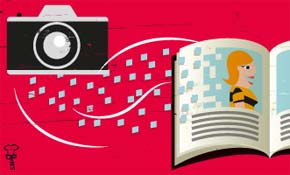
Photography is going through a revolution. Again. Today, film rolls, negatives and darkrooms seem like a distant memory. Digital cameras and camera phones are everywhere.
But while we’re busy snapping away our lives, our digital identity isn’t stored on paper, but on CDs, computers, mobile phones and social media sites. Consumers are waking up to the idea they still need print. They want to archive their photos in a format that will last generations. They want to share their identity online and offline. However, they’re still ordering 4×6 silver halide prints, carefully handling them by the edges and spending countless hours slotting photos into little plastic sleeves. With these photo albums, you only get one copy, unless you’re willing to repeat the painstaking process.
Digital printing has opened a new market and greater opportunities in photo publishing. Consumers can design and publish their own photobooks using intuitive software and pre-designed templates. Plus they’re not limited to one copy. For printers who already own a photo-quality digital press and finishing equipment, the additional software investment required to build a complete photobook production platform is comparably low.
There are models for printers to enter the market: Business to Consumer (B2C), Business to Business (B2B) and Business to Business to Consumer (B2B2C).
B2C is by far the most ambitious, but provides significant opportunity for those who can make it work. Getting established in the B2C market takes a lot of time, money and patience. To reach consumers, you have to market to them – and this is something where the majority of printers lack experience. You can’t just “build a website and they will come”, you need to invest in establishing your brand through advertising both online and offline, which can prove a costly exercise.
In B2B, products are sold directly to a business or organisation. One example is a school, which might use a photobook in fundraising activities.
The third category is B2B2C. This refers to a model where a printer partners with a distribution channel, such as a retailer, which markets and sells photobooks. The retailer sells the book to their customer, but the order is fulfilled by the printer. The advantage of this model is that the channel can leverage their existing customer base and attract them to purchasing photobooks, often as a value-add.
Whatever model you choose, research is critical. You need to understand not only the market, but also the technology, marketing and customer support. Look at closely your target market, see what products are offered and how they are priced. Don’t feel tempted to take the bottom out of price as a knee-jerk to competitive pressure. While others may try, it’s usually short-lived and not a sustainable model.
There’s plenty of opportunity for early adopters to take advantage of this market but it takes more than investing in a piece of software alone. You need to research, invest, develop, promote, support, persevere – and most importantly, be realistic.
Eliot Harper is managing director of creative publishing firm eliot (www.eliot.com.au) and distributes Taopix photobook software in ANZ
Comment below to have your say on this story.
If you have a news story or tip-off, get in touch at editorial@sprinter.com.au.
Sign up to the Sprinter newsletter
